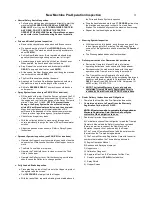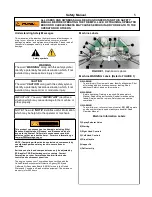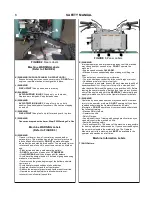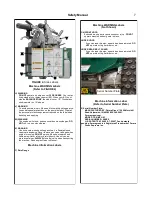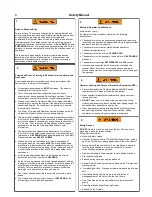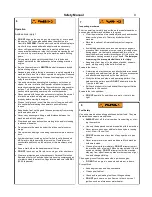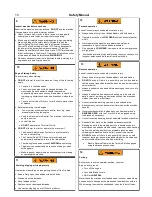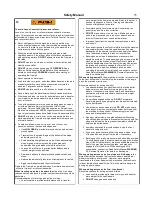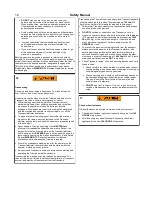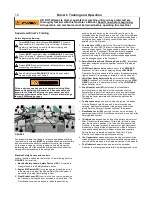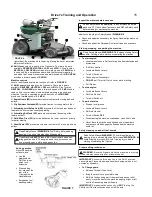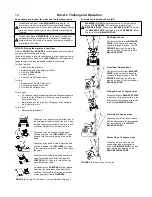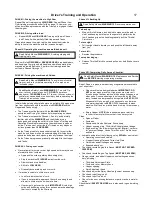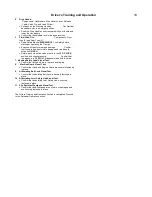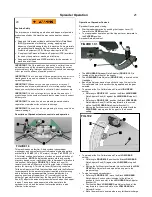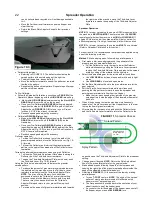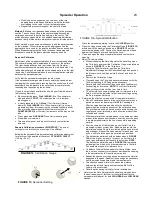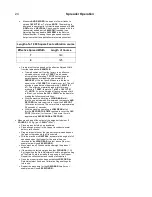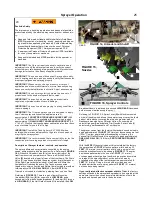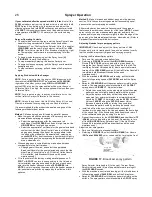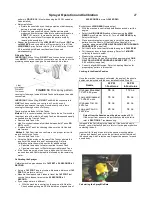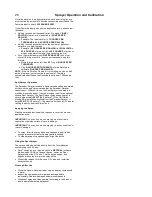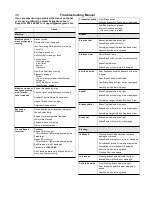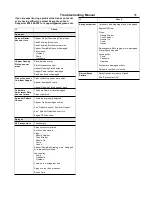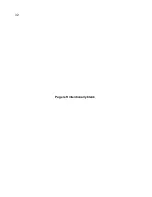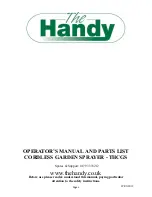
Driver’s Training and Operation
17
PHASE VI: Driving over curbs.
Never attempt to jump a curb at high speed as this may cause
a forward tip-over. Instead:
Approach the curb or parking block straight on;
Stop the machine
12 INCHES
away from the curb;
Dismount and drop handles;
Shift into
LOW GEAR
;
Gradually accelerate up and over curb.
If machine is unable to climb over a curb:
Look for a lower section of curb;
If one is not available, approach the curb on an angle and
attempt to climb over one wheel at a time;
Use ramps to get over the curb.
IMPORTANT
: Avoid high
curbs and bottoming out as this can cause machine damage
that is not covered by the Warranty.
PHASE II: Driving the machine in High Gear.
Repeat Phase I training using
HIGH GEAR
. Repeat Phase I Low
Gear training procedures as set forth on page 15. However, you
will perform these procedures with the Triumph in high gear rather
than low gear.
PHASE III: Driving with a load.
Repeat
LOW
and
HIGH GEAR
Training outlined in Phase I
and Phase II with a partially filled Hopper and Tanks
Gradually increase the weight as the trainee demonstrates his
ability to control the machine with the increased weight.
Phase VII: Backing Up.
To back up:
Stop, shift into Reverse, look behind to make sure the path is
clear, and keeping both feet on the operator’s platform and a
firm 2 handed grip on the handles gradually pull the Throttle/
Clutch Lever.
To turn right:
Pull the right Handle toward you and push the left handle away
from you.
To turn left:
Reverse the procedure.
To stop backing up:
Release Throttle/Clutch Lever and pull one or both Brake Levers
to stop.
Read Safety Manual
WARNING 13
, Reverse operation now
Phase VIII: Completing Daily Service Checklist.
Adjust, Repair, replace, and report any irregularities discovered to
your supervisor.
Clean machine in a designated area.
IMPORTANT
:
DO
NOT
power wash machine. High pressure water will
force corrosive fertilizer residue into bearings, linkages, and
other parts. Corrosion damage is not covered by the War-
ranty. Instead use low pressure air regulated to
29 PSI
(200
Kilopascals). Once a week, or as necessary, use low pres-
sure water regulated to
29 PSI
(200 Kilopascals) to wash
machine. Start and run machine and blow dry to remove any
water.
Empty Hopper.
NOTE
: Use a dedicated pail or wet /dry
vacuum to remove fertilizer so that it can be recycled.
Clean:
Spinner Platter.
Footpads.
Nozzles and Nozzle Strainers, If necessary.
Hopper opening plate, Third-Hole Slide plate and linkage.
Engine cooling fins, Blower housing inlet (Starter), carbure-
tor, governor linkage, Honda Throttle Lever, Throttle Lever
and cable.
Lubricate and protect the following, using
WD-40
or equivalent:
Operating controls and cables.
Hopper Opening Plate and Third-Hole Plate.
Carburetor and all linkages and springs.
Exposed aluminum.
Check and record Engine Idle Speed (
MUST NOT EXCEED
1650 RPM
).
Check and record Engine Top Speed (
MUST BE 3,450 RPM
).
Gauge, record, and adjust Hopper control settings as neces-
sary, including:
Third-hole Adjustment Plate.
Third-hole Lever Memory-Lock.
Hopper opening.
Rate Adjustment Knob
Check and adjust the Spray Nozzle alignment as necessary.
Check and top off engine oil.
Check and top off clutch oil.
Check for loose or missing fasteners or parts, cracks in metal or
welds.
Check that all
SAFETY DEVICES
are in place and in good working
order.
Read Safety Manual
WARNING 19
, Maintenance and Service
now
BEFORE
starting or operating machine.
Phase IV: Operating the machine as a walk-behind unit.
Stop, shift into
LOW GEAR
or
REVERSE GEAR
, drop handlebars,
and keeping a firm grip on both handles and while operating the
machine as a walk behind unit, perform the training procedures
outlined in Phases I through IV.
Read Safety Manual
WARNING 11
, Avoiding slipping and
tripping injury now
PHASE V: Driving the machine on hillsides.
Initial hillside training should take place on a slightly hilly open area
free from obstructions with the machine in
LOW GEAR
and the
Hopper and Tanks empty.
The Trainee must be familiar with the
BALANCE ZONE
principles and Driving Techniques before operating on slopes.
The Trainee must pass the Phases I, II and IV and be totally
familiar with all the
WARNINGS
and the hillside driving
techniques and principles set forth in the Driver’s Training and
Operating Manual before operating the machine on a slope or
incline. Trainee must never ride the Triumph on any slopes or
inclines greater than
15 DEGREES
.
As the Trainee is able to demonstrate his ability to control the
machine on hills as well as his understanding of hillside driving
principles and proper techniques; gradually increase the slope.
As the Trainee progresses, gradually add weight to the Hopper
and Tanks.
Read Machine Safety Label
WARNINGS
:
C
, To avoid Tip-
over, rollover, or loss-of-control
T
,
DO NOT
operate on
slopes over
15 DEGREES
; and
P
, Tip-over, rollover, or loss-of-
control may cause death or serious injury before operating the
Triumph on an incline or slope.
Read Safety Manual
WARNING 15
, To avoid loss-of-control,
tip-over, and rollover before operating the Triumph on an
inclined or slope.

